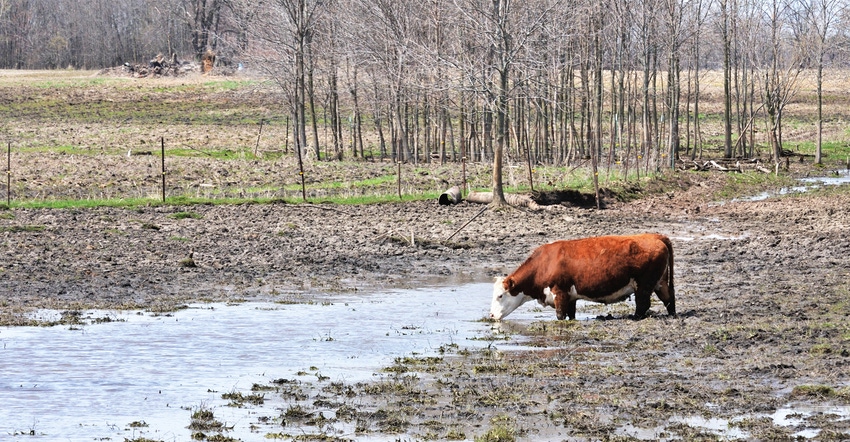You might be ready for spring, but are your cattle’s hooves ready? Spring can bring wet, muddy conditions that weaken hooves and make cattle vulnerable to injury. Here’s some tips on how good nutrition can help.
February 28, 2019

Sponsored Content
Late winter and early spring typically involve wet, muddy ground, which can be particularly problematic for hooves. From foot rot to cracking, poor hoof health can take a real toll on livestock, regardless of the species. Wet seasonal conditions weaken and soften hooves, making them more vulnerable to injury and bacteria.
The best way to combat these issues is to first grow a strong, hard hoof. Proper nutrition can go a long way in helping you accomplish this. It’s important to develop an understanding of hoof structure and the key role of mineral nutrition so that you can take an educated approach to feeding for hoof health.
Hoof composition
Hooves primarily consist of a special protein called keratin, which is composed of amino acids and forms twisted strands that provide extra strength and elasticity. These strands twist together in a rope-like fashion and are linked by sulfur bonds between sulfur-containing amino acids in opposing keratin strands for added strength.
The outermost layer of the hoof contains dead keratin, along with fat and wax, which are responsible for sealing moisture into the hoof when the layer is intact. This layer also gives the hoof its shine and smoothness.
The impact of nutrition
Since hooves are so metabolically active, the quality of an animal’s overall diet is often very evident in the appearance of its hooves. The hoof of an adult animal will generally grow out and replace itself in about one year’s time. Since hooves are primarily composed of protein and fats, animals must receive adequate levels of both crude protein and fatty acids. Sulfur-containing amino acids are also of particular importance for non-ruminants.
Mineral nutrition’s vital role in hoof health may not be readily apparent, but each mineral is crucial in different ways:
Calcium is required for the activation of the enzyme needed to form keratin. It is also required for the process of creating crosslinks between keratin fibers.
Zinc is very important for hoof growth and maintenance and is essential for the formation of keratin. It also influences calcium utilization in the body and plays a very important role in the formation of superoxide dismutase, an enzyme involved in antioxidant activity that prevents the fats and oils in the hoof from oxidizing and breaking the protective seal, which can cause the hoof to become dry and brittle.
Copper is vital for the formation of the crosslinks in the keratin that keep the hoof strong and hard. It is also a critical component of superoxide dismutase.
Selenium plays an important antioxidant role in the hoof, also protecting the fats from oxidation.
Animals with even a marginal deficiency in these nutrients are likely to experience the following symptoms:
Slow hoof growth
Soft hooves
Cracks
Abscesses
Laminitis
Thin hoof walls
Foot rot/thrush
Feeding guidance
The specific kinds and amounts of nutrients necessary for optimum hoof health will vary from species to species. Animals grazing on ample amounts of lush pasture generally aren’t lacking in crude protein and fats. Calcium deficiency is not a common issue, especially in areas with hard water. However, zinc, copper and selenium levels are marginal to deficient in much of the soil throughout the United States. For this reason, most beef cattle respond well to supplementation of these three trace minerals.
The importance of trace mineral nutrition
Time and again, independent research has shown that organic, chelated forms of trace minerals are more efficiently digested by the body and retained in tissues for later use. CRYSTALYX® Brand Supplements offer a wide variety of choices in the delivery of organic Bioplex® zinc and copper in the Blueprint® product line.
Blueprint® is a premium organic trace mineral nutrition program based on decades of practical application. Blueprint® exclusively features Bioplex® organic trace minerals and helps unlock the genetic potential of livestock by supporting animals throughout all phases of production. Bioplex® organic trace mineral proteinates resemble those found naturally in plant proteins, which means increased availability with less interference by antagonists and less oxidative stress, contributing to improved performance.
As you can tell, an animal’s diet has a major impact on the quality and overall health of its hooves. Protein, fat, calcium, zinc, copper and selenium all play vital roles. Supplementation of these key nutrients can help your livestock maintain or improve their hoof health. It’s important to remember that the hoof grows relatively slowly, so it may be several months before you notice an improvement, and it can take a year or more for the hoof to obtain the full benefits. CRYSTALYX® Brand Supplements can help ensure that your livestock get the nutrients they need for healthy, strong hooves. For more nutritional information on specific products in the CRYSTALYX® Blueprint® product line, or to find your local dealer, visit www.crystalyx.com.
About the Author(s)
You May Also Like



